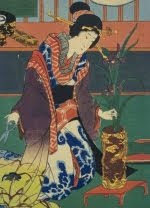
What would your ikebana be if you got a chance to arrange in Isamu Noguchi‘s iconic vase “Lonely Tower”? Wishful thinking, yet an inspirational challenge. I'm reposting these beautiful pictures via "The improvised life" blog: "Lonely Tower", Shigaraki stoneware with thin ash glaze, 1952.
Noguchi who was half Japanese came to Japan in the 1950s to discover his roots. Here he made some fantastic ceramics and got to know Sofu Teshigahara, headmaster of the Sogetsu School of ikebana, and his son Hiroshi Teshigahara. The friendship also resulted in a professional collaboration.

Here's what Sofu came up with when he got to create an ikebana in "Lonely Tower".
Dore Ashton comments on one example of the collaboration, Nogouchi's interior garden design in Sogestu plaza 1974, in the book Nogouchi East and West:
"Perhaps unconsciously, Nogouchi went so far as to echo Teshigahara's markedly expressionist temperament, using great slabs of rough-hewn granite that clash like temple cymbals and serve as foils for the ephemeral plant arrangements."












